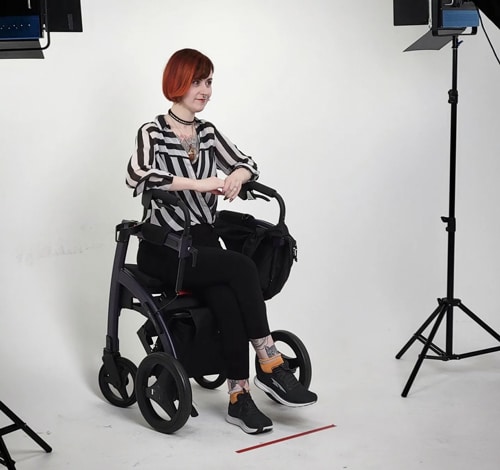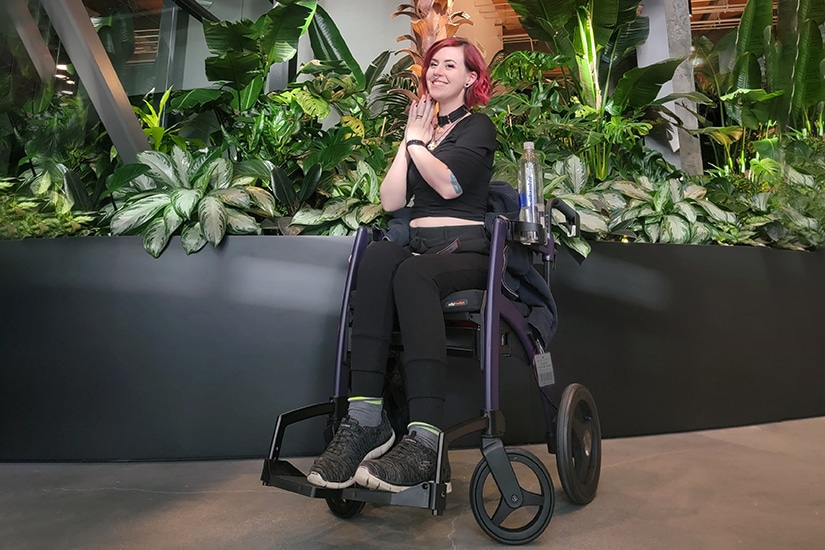According to the American Center for Disease Control & Prevention, one in four adults in the United States has a disability that affects their daily life. Despite being disabled, a highly respected hair stylist and beauty educator from Kitsap County has refused to add to these numbers. Preston’s unwavering determination and positive attitude are a source of inspiration, motivating her to continue moving forward.
Instead of allowing her condition to hold her back, Preston has focused on adapting and pursuing her passion. Her resilience and ability to overcome adversity are truly remarkable and serve as a reminder that anything is possible with the right mindset and attitude. It is essential to acknowledge people like Preston, who refuse to let their disabilities define them and choose to focus on their abilities and passions.
Preston has been diagnosed with Mast Cell Activation Syndrome, Postural Orthostatic Tachycardia Syndrome (POTS) and Hypermobile Ehlers Danlos Syndrome, which has made her journey more demanding and strenuous.
“My medical issues started in 2007, they were mild and sporadic and got worse by the time I was in beauty school. It has taken me 15 years, two misdiagnoses and a lot of specialists to actually get answers.”
“With disabilities, you end up going through grief more than once. It’s not just when you find out you’re disabled, it’s a roller coaster of recurring emotions. Take me as an example, after 5 years into the journey and lots of ups and downs, I realized it wasn’t going to be better, so I had to learn how to cope with that. I had to learn how to process my emotions, honor them, let them pass and focus on what was in my power to achieve, which was still a lot!”
Coping with being disabled
Preston explains that in order to continue practicing her job and inspiring people, she had to adapt her way of working and as well as the necessary tools, from opting for lighter-weight hairstyling instruments to using mobility-aids.
“It changes from day to day. I have what’s called a dynamic disability. There are times when I can move, there are other times when I’m a little slower, more cautious, and I’m using a cane. And then there’s days that are really bad and you’ll see me with my rolling walker or even an ambulatory wheelchair.”
Mobility aids become an extension of you
When out alone, she relies the most on her Rollz Motion, which offers her two mobility options in one – a great feature that suits her ever-changing mobility state and helps maintain her independence.
 “One of the tools you’ll see me with when I’m out and about by myself is my Rollz rollator – wheelchair 2 in 1. It has locking brakes so I can park it whenever I need, a curb kick, which you cannot find with all mobility aids, and you can even attach a cup holder, which is amazing, since I used to spill all my coffee everywhere, ha ha! You can sit on it when using it as a rollator – it’s comfy and cozy – or you can turn it into a wheelchair by putting up the wheelchair package. It’s extremely easy and it takes two seconds!”
“One of the tools you’ll see me with when I’m out and about by myself is my Rollz rollator – wheelchair 2 in 1. It has locking brakes so I can park it whenever I need, a curb kick, which you cannot find with all mobility aids, and you can even attach a cup holder, which is amazing, since I used to spill all my coffee everywhere, ha ha! You can sit on it when using it as a rollator – it’s comfy and cozy – or you can turn it into a wheelchair by putting up the wheelchair package. It’s extremely easy and it takes two seconds!”
“When I start to get really symptomatic, this becomes really handy. For the longest time I didn’t go anywhere, I didn’t do anything, and now I’m even travelling by myself and going on adventures with friends, thanks to my Rollz.”
In line with her job description, Preston values aesthetics and she likes giving a personal touch to her mobility devices, in the same way that one would style their appearance: “It’s the same as decorating your body, either with clothes, or tattoos – it’s an extension of you. My chair is a part of me. That’s why it’s important not to touch people’s chairs without consent.”
The importance of universal accessibility
As an educator, trainer in her field and a disability community speaker, Preston occasionally needs to travel. Her unfortunate experiences with airport services highlight the need to raise awareness on issues of accessibility and inclusion.
“I did get treated like furniture at the airport at one point. Got run into multiple times while in my wheelchair. I was like: “Ahh, I’m a person!” and they didn’t even acknowledge or say sorry.”
She has made it her objective to drive positive change in society, convinced that awareness is the first and most important aspect to creating an accessible environment that benefits everyone.
“My biggest goal is to help disabled people build their voice, to advocate for themselves and others, but also teach able-bodied folks become more aware. You can’t know what you don’t know, if you haven’t dealt with it.”
“Accessibility for disabled people means accessibility for everyone. A ramp would still benefit a mom with a stroller, as it benefits me in a wheelchair. It’s all those little things that people don’t realize until they’re being put in a position of having to realize it. And it doesn’t take away from anything by making things accessible.”
Addressing internalized ableism
Internalized ableism is a common phenomenon among people with disabilities. It is the belief that one should be able to perform tasks that able-bodied people can do, leading to harmful behaviors, such as one pushing themselves beyond their limits and exacerbate existing conditions. It is essential to recognize and address internalized ableism to foster safety and inclusion.
“In one of my presentations for educators I brought the attention on the internalized ableism and the fact that it’s considered the default, the normal. That puts a lot of pressure on disabled people: “I should be able to do that”. I’ve done that myself and I’ve ended up causing more harm to my own body, because I pushed it too hard.”
While acknowledging that there is still a long way to go before achieving universal accessibility, Preston takes an active role in the process and finds it both empowering and meaningful to contribute to the cause.
“I like being able to educate people. I want to be able to see things change in real time and I know the only way to do that is to stay involved.”
